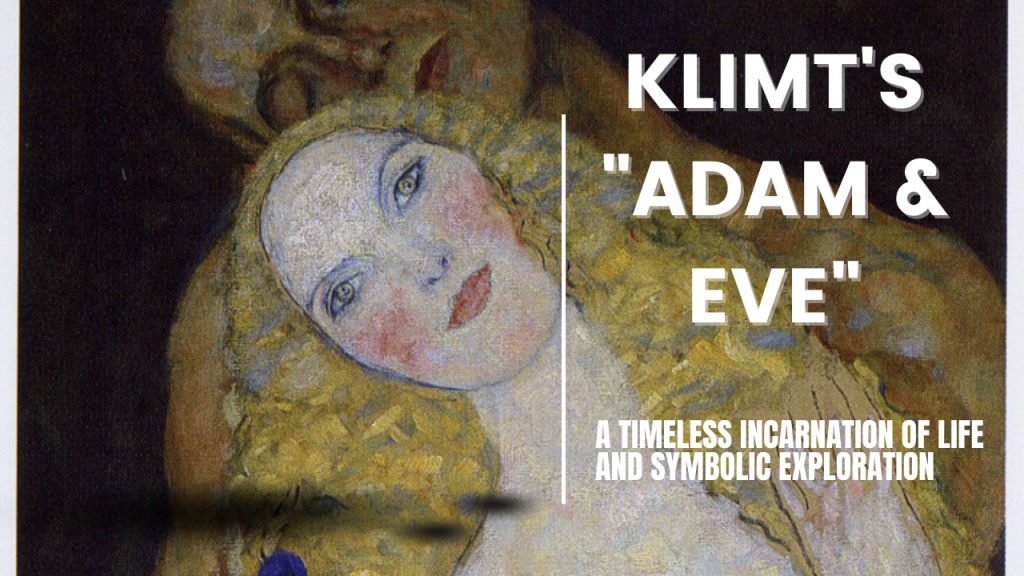Smriti Malhotra
Gustav Klimt, renowned for his opulent and symbolic paintings, ventured into biblical themes with a remarkable work titled “Adam and Eve.” Unlike his other creations, this painting stands as a singular instance within Klimt’s oeuvre that draws inspiration from the biblical creation story. “Adam and Eve” presents a unique interpretation, evoking a timeless incarnation of Eve as the mother of life while sidestepping explicit depictions of significant episodes such as the Fall of Man.

Courtesy: Google Arts and Culture
In this artwork, Klimt manifests his fascination with the archaic and primordial. The portrayal of Eve, with her full-bodied figure and broad hips, exudes an aura reminiscent of prehistoric idols and tribal artefacts. Klimt seeks to capture the essence of Eve as the embodiment of life-giving femininity, transcending specific biblical events and entering the realm of universal symbolism.
At Eve’s feet, we find vibrant anemone flowers, their colourful petals concealing her lower extremities. The anemone holds deep symbolic meaning, representing fertility and the eternal cycle of life. By incorporating this floral element, Klimt reinforces the idea of Eve as the source of life’s continuity, underscoring her role as the mother of all humanity.
Positioned behind Eve, a leopard hide adorns the scene, adding a layer of complexity to the symbolism within the painting. This element can be interpreted in various ways, including references to Greek mythology. The maenads, wild and ecstatic female followers of Dionysus, were often associated with leopard skins, symbolising unbridled and untamed erotic love. Klimt’s inclusion of the leopard hide suggests a connection between Eve’s primordial nature and the powerful forces of desire and passion that drive human existence.
Klimt’s dedication to portraying the human form in all its sensuality is evident in his depiction of Eve’s body. With meticulous effort, he creates a colourful figure, employing soft skin tones mingled with delicate blues and yellows. This palette enhances the luminosity of Eve’s body, making it the focal point of the painting. The vibrant hues set her apart from Adam, whose bronzed physique serves as a protective frame around Eve. The contrasting colors and positioning symbolize the eternal dance between masculine and feminine energies, emphasizing their inherent harmony.
The unfinished nature of “Adam and Eve” adds an intriguing layer of mystery and reflection on Klimt’s artistic journey. This painting remained one of the last works he labored upon before his untimely passing. Its incompleteness raises questions about the artist’s intentions and invites viewers to engage in a dialogue with the piece. Klimt’s deliberate choice to leave the work unfinished suggests that art is a continuous exploration, an ongoing process that extends beyond the boundaries of a completed canvas.
The significance of “Adam and Eve” extends beyond its imagery and symbolism to the personal connection between the painting and Sonja Knips. Knips, a friend of Klimt and the subject of his famous portrait, acquired the artwork from the artist’s estate. This acquisition further amplifies the emotional and historical context surrounding the piece, as it speaks to the intimate relationship between the artist and the subject, transcending mere aesthetic appreciation.
Gustav Klimt’s “Adam and Eve” is a captivating exploration of biblical themes and the timeless essence of femininity. Through its distinct symbolism and aesthetic choices, the painting offers a nuanced interpretation of Eve as the eternal mother of life, transcending specific biblical events. Klimt’s meticulous attention to detail, use of colour, and exploration of archaic forms create a visually stunning and thought-provoking artwork. The presence of the anemone flowers symbolising fertility, the leopard hide evoking primal desires, and the contrasting portrayal of Adam and Eve contribute to the painting’s depth and complexity.
Klimt’s dedication to capturing the essence of Eve as a symbol of life and femininity is evident in the meticulous rendering of her form. The soft skin tones, blended with blues and yellows, lend a luminous quality to her figure. Klimt’s attention to detail and his deliberate use of colour draw the viewer’s gaze to Eve, emphasising her significance as the focal point of the painting. In contrast, Adam’s bronze-toned body serves as a protective frame, underscoring the interplay between masculine and feminine energies.
The personal connection between Sonja Knips and the painting adds another layer of significance. As a friend of Klimt and the subject of his famous portrait, Knips’s acquisition of “Adam and Eve” highlights the intertwined relationships between the artist, the subject, and the art itself. It reinforces the emotional and historical context surrounding the painting, deepening our understanding of the intimate connections that exist within Klimt’s artistic world.
Furthermore, the symbolism within the painting extends beyond biblical references. The inclusion of the leopard hide alludes to Greek mythology and the wild, untamed nature of human passion. It speaks to the complexity of human emotions and desires, hinting at the profound forces that shape our existence.
Gustav Klimt’s “Adam and Eve” stands as a testament to his artistic vision and exploration. Through the portrayal of a timeless incarnation of Eve, Klimt invites viewers to contemplate the essence of life, femininity, and human desires. As we engage with Klimt’s “Adam and Eve,” we are drawn into a world where biblical narratives intertwine with primal symbolism, evoking profound questions about life, femininity, and the eternal dance between masculine and feminine energies.
To read 11 Things You Didn’t Know About Gustav Klimt. Click here
Check Adam and Eve on Google Arts & Culture. Click here





